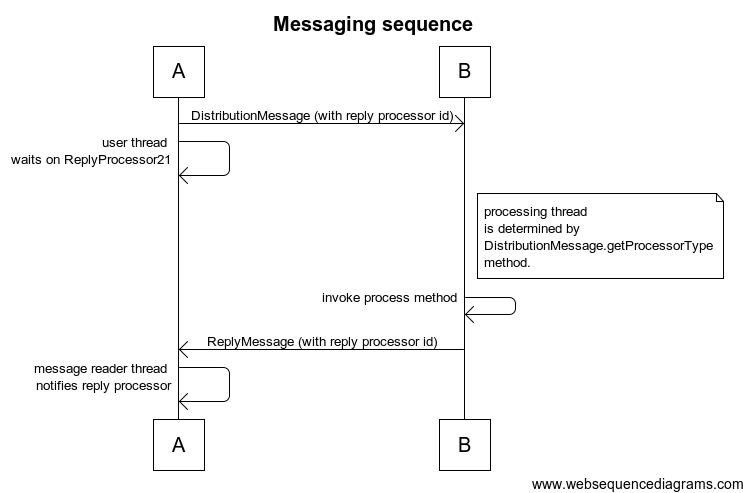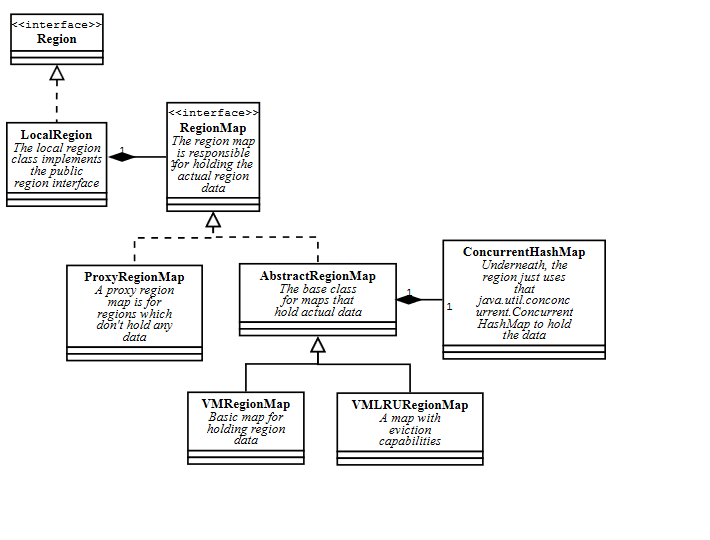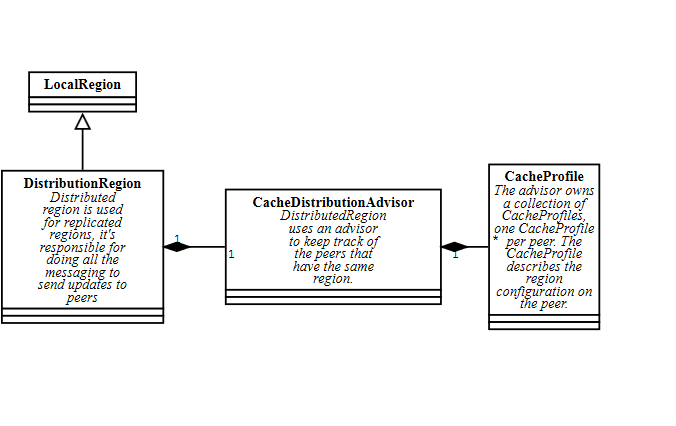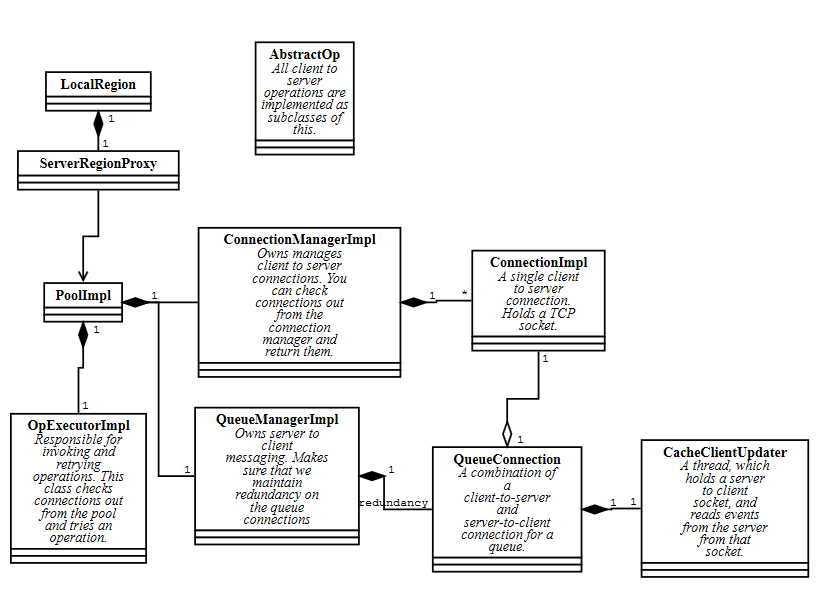...
InternalDistributedSystem - this is the singleton that manages the connection to the distributed system
LonerDistributionManager, DistributionManager - InternalDistributedSystem owns one of these, which do the actual messaging. This is instance DistributionManager for peers or servers. Members that cannot have peers because of their configuration are "loners". A client is the most common case for a loner. Both of these classes implement DM.
GemfireCacheImpl - This is the singleton that owns all of the cache related resources. It implements the Cache interface and owns all of the regions, disk stores, cache servers, etc.
Serialization
Geode has its own serialization framework, which is available to customers that implement the DataSerializable interface. You should look at the public documentation on DataSerializable and DataSerializer to become familiar with how to use this framework.
Internal classes are serialized with the same framework, but we don't use the public Instantiator framework. Instead internal classes implement DataSerializableFixedID. See the javadocs on DataSerializableFixedID for how this works.
Logging and Statistics
Geode uses log4j2 for logging. To get a logger add a static logger field to your class
...
To view statistics, use the vsd tool. See [Using VSD]
Messaging
Member names
From a given member, you can refer to other members by using an InternalDistributedMember. When you send a message to a peer, you pass InternalDistributedMember objects to indicate that destinations. The DM provides methods to get all list of all of the currently running peers, and to add listeners to learn about peers coming and going. However, you may end up getting the list of members from a DistributionAdvisor instead. See the advisors section below.
...
To send a message, create an instance of your DistributionMessage subclass, call setRecipient or setRecipients to indicate the destination, and call DM.putOutgoing(yourMessage). The message will be sent to the recipients.
ReplyProcessor21 and ReplyMessage
Being able to send a message is great, but you also need to be able send a request that gets a response, or wait until you are sure that peer has processed a message.
...
Finally, when the ReplyMessage is received on the original sender of the message, it looks up the ReplyProcessor and notifies it. That wakes up the thread in processor.waitForRepliesUninterruptibly().
Advisors
The distribution manager keeps track of all of the peers. However, for many cases, we actually want to form sub groups within the distributed system. For example, we might want to be sending messages just to the peers that have a particular region.
...
Different components use different subclasses of DistributionAdvisor and Profile. For example, DistributedRegion uses a CacheDistributionAdvisor which exchanges CacheProfile objects. CacheDistributionAdvisor provides special methods to get subgroups of peers based on the contents of their profiles. For example CacheDistributionAdvisor.advisePersistentMembers() returns only the members that are using persistence with the given region.
Regions
LocalRegion
LocalRegion is the base class for other types of regions. A local region implements the public Region interface and holds the map with the region data.
DistributedRegion
The DistributedRegion class is what we use for replicated regions. A distributed region extends a local region, but has an advisor for messaging.
Partitioned Regions
When the user creates a partitioned region, we create an instance of the PartitionedRegion class. Essentially, the way a partitioned region works is that for every key the user puts, we take the hash code of the key to determine the bucket the key should go to. Buckets are then assigned to individual members. The partitioned region makes sure that we make enough copies of the bucket to satisfy the redundancy level.
...
There are some slides an and outline about partitioned regions here - [~dsmith:Internals talks]
Clients and Servers
Client Server Messaging
Client server messaging is implemented differently than the peer to peer messaging layer. The server side part of the messaging is implemented in com.gemstone.gemfire.internal.cache.tier.sockets.command Each message type has it's own server side class, which reads that particular message, processes it, and replies.
The client side of the messages are in com.gemstone.gemfire.cache.client.internal as the subclasses of AbstractOp. These operations are responsible for sending the message and reading the reply.
Server side
The server code is implemented in BridgeServerImpl and AcceptorImpl. AcceptorImpl has the actual server socket and run loop which accepts connections on that socket.
...
The thread reading from the connection is implemented in ServerConnection.
ClientSide
On the client side, the client to server connections are managed PoolImpl. Each client region holds a ServerRegionProxy on which the region can invoke operations. The proxy uses the pool to send the operation to the server side.
Client queues
Clients can subscribe to events with Region.register interest or with continuous queries. They will receive updates when the events change on the server side through an asynchronous queue.
Persistence
Each member writes to it's own independent disk store. Members never share the disk artifacts. For example, if a new member needs to create a copy of a region, we read the disk files from one member, send the logical keys and values to the other member, and that member writes it's own disk files.
...
To prevent the oplogs from growing forever, old oplogs are compacted. When over 50% of the data in an old oplog is garbage (because there are newer updates to the same keys in a newer oplog), the remaining data is copied forward to the current oplog and the old oplog is deleted from disk.
Querying and Indexes
Geode provides a SQL-like querying language called OQL that allows applications to access data stored in regions.
...





